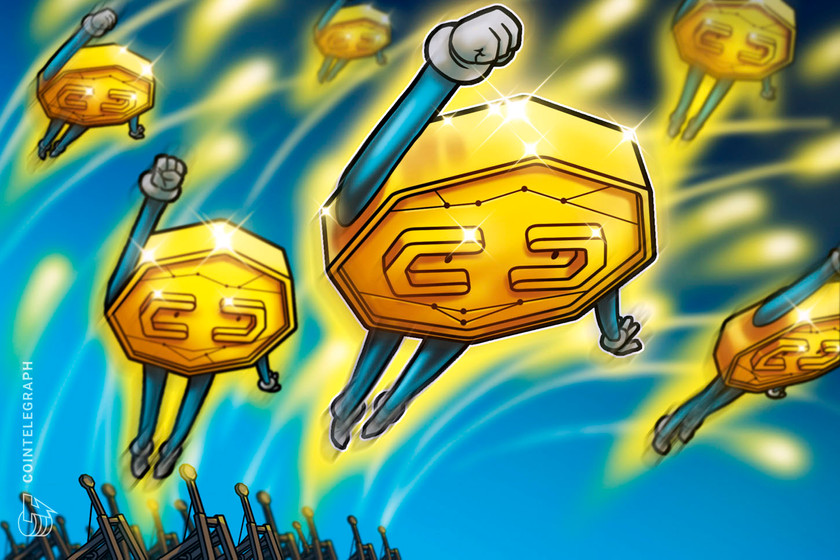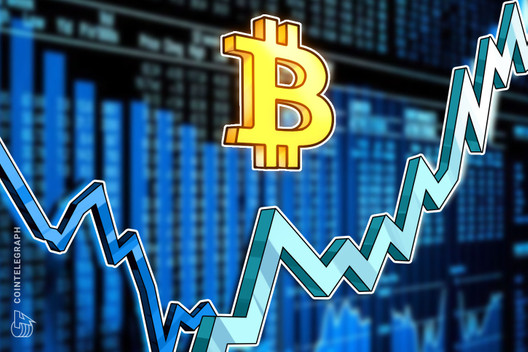Why low latency is important for cryptocurrency exchanges, explained
What is Bitcoin? How does blockchain work? How to mine cryptocurrency? We are glad to help you answer these questions with our quick guides in Explained section.
n”,”seo_description”:”What is Bitcoin? How does blockchain work? How to mine cryptocurrency? We are glad to help you answer these questions with our quick guides in Explained section.”},”words_count”:918,”description”:”Low latency is essential for high-end cryptocurrency traders, but not all exchanges can offer it. We’ll explore why it’s important and where to find it”,”author”:{“id”:683,”title”:”Frank Edwood”,”url”:”frank-edwood”,”twitter”:””,”google_plus”:””,”photo”:””,”gender”:”male”,”description”:”Frank has been fascinated by technology his whole life, and first got into cryptocurrency in early 2017. He has years of experience with writing as well as technical analysis, and joined Cointelegraph in 2019.”,”facebook”:””,”email”:”frankedwood@cointelegraph.com”,”linkedin”:””,”created_at”:”2019-07-01 16:38:50″,”updated_at”:”2020-02-03 12:21:52″,”deleted_at”:null,”avatar”:”https://cointelegraph.com/assets/img/icons/author_male.jpg”,”hash”:”aHR0cHM6Ly9jb2ludGVsZWdyYXBoLmNvbS9hdXRob3JzL2ZyYW5rLWVkd29vZA==”,”relativeUrl”:”https://cointelegraph.com/authors/frank-edwood”,”user_id”:683,”language_id”:1,”name”:”Frank Edwood”,”desc”:”Frank has been fascinated by technology his whole life, and first got into cryptocurrency in early 2017. He has years of experience with writing as well as technical analysis, and joined Cointelegraph in 2019.”,”seo_title”:”Frank Edwood’s articles on Cointelegraph”,”seo_description”:”Frank has been fascinated by technology his whole life, and first got into cryptocurrency in early 2017. “,”enabled”:1,”show_in_authors”:0,”show_in_experts”:0},”category_id”:65,”audio”:”https://s3.cointelegraph.com/audio/54916.fd62d2f3-1b5d-41c5-92e8-b71c014bec6f.mp3″,”tags”:[{“name”:”HitBTC”,”uri”:”/tags/hitbtc”,”super”:0,”page_title”:”HitBTC News”},{“name”:”Technology”,”uri”:”/tags/technology”,”super”:1,”page_title”:”Technology News”}],”tag_title”:”Technology”,”date”:”38 MINUTES AGO”,”badge”:{“title”:”Explained”,”label”:”default”},”qty”:0,”stats_pixel”:”“,”stats_pixel_url”:”https://zoa.cointelegraph.com/pixel?postId=54916®ionId=1″,”shares”:14,”infographic”:false,”sponsored”:false,”explained”:true,”press_release”:false,”show_referral”:false,”social_description”:””,”social_translators”:{“clipboard_popup_label”:”Link copied”,”socialWechatFooterError”:”WeChat error”,”socialWechatFooterText”:”WeChat share”,”socialWechatHeaderText”:”WeChat share”},”social_shares”:{“post_id”:54916,”post_url”:”https://cointelegraph.com/explained/why-low-latency-is-important-for-cryptocurrency-exchanges-explained”,”post_titles”:{“normal”:”Why low latency is important for cryptocurrency exchanges, explained”,”twitter”:”Why low latency is important for cryptocurrency exchanges, explained”},”post_text”:{“normal”:”Why low latency is important for cryptocurrency exchanges, explained”,”twitter”:”Why low latency is important for cryptocurrency exchanges, explained https://cointelegraph.com/explained/why-low-latency-is-important-for-cryptocurrency-exchanges-explained via @cointelegraph”},”accounts”:{“twitter”:”@cointelegraph”}},”socials”:{“facebook”:{“url”:”https://www.facebook.com/sharer/sharer.php?u=https%3A%2F%2Fcointelegraph.com%2Fexplained%2Fwhy-low-latency-is-important-for-cryptocurrency-exchanges-explained”,”count”:null,”short”:”fb”,”fa”:”facebook”},”twitter”:{“url”:”https://twitter.com/intent/tweet?text=Why+low+latency+is+important+for+cryptocurrency+exchanges%2C+explained https%3A%2F%2Fcointelegraph.com%2Fexplained%2Fwhy-low-latency-is-important-for-cryptocurrency-exchanges-explained via @cointelegraph”,”count”:null,”short”:”tw”,”fa”:”twitter”},”telegram”:{“url”:”https://telegram.me/share/url?url=https%3A%2F%2Fcointelegraph.com%2Fexplained%2Fwhy-low-latency-is-important-for-cryptocurrency-exchanges-explained &text=Why+low+latency+is+important+for+cryptocurrency+exchanges%2C+explained”,”count”:null,”short”:”tg”,”fa”:”paper-plane”},”whatsapp”:{“url”:”https://api.whatsapp.com/send?text=Why+low+latency+is+important+for+cryptocurrency+exchanges%2C+explained&href=https%3A%2F%2Fcointelegraph.com%2Fexplained%2Fwhy-low-latency-is-important-for-cryptocurrency-exchanges-explained”,”count”:null,”short”:”wu”,”fa”:”whatsapp”},”gplus”:{“url”:”https://plus.google.com/share?url=https%3A%2F%2Fcointelegraph.com%2Fexplained%2Fwhy-low-latency-is-important-for-cryptocurrency-exchanges-explained”,”count”:null,”short”:”gplus”,”fa”:”google-plus”},”reddit”:{“url”:”https://www.reddit.com/submit?url=https%3A%2F%2Fcointelegraph.com%2Fexplained%2Fwhy-low-latency-is-important-for-cryptocurrency-exchanges-explained&title=Why+low+latency+is+important+for+cryptocurrency+exchanges%2C+explained”,”count”:null,”short”:”reddit”,”fa”:”reddit-alien”},”linkedin”:{“url”:”https://www.linkedin.com/shareArticle?mini=true&url=https%3A%2F%2Fcointelegraph.com%2Fexplained%2Fwhy-low-latency-is-important-for-cryptocurrency-exchanges-explained&title=Why+low+latency+is+important+for+cryptocurrency+exchanges%2C+explained”,”count”:null,”short”:”li”,”fa”:”linkedin”}},”hide_disclaimer”:false,”elink”:”https://hitbtc.com/”,”etitle”:”Partnership material”,”elogo_x2″:”https://images.cointelegraph.com/images/528_aHR0cHM6Ly9zMy5jb2ludGVsZWdyYXBoLmNvbS9zdG9yYWdlL3VwbG9hZHMvdmlldy81YjJlMWQxMDEzNjc1ZDFkOGFjNGQxNDljNDFiYjBlNC5qcGc=.jpg”,”elogo_x1″:”https://images.cointelegraph.com/images/260_aHR0cHM6Ly9zMy5jb2ludGVsZWdyYXBoLmNvbS9zdG9yYWdlL3VwbG9hZHMvdmlldy81YjJlMWQxMDEzNjc1ZDFkOGFjNGQxNDljNDFiYjBlNC5qcGc=.jpg”,”elogo_svg”:false,”content”:[{“id”:2022,”post_id”:54916,”title”:”What is latency, and how does it affect trading?”,”content”:”
Latency refers to the speed of data transmission, which, for online traders, has a notable effect on how fast they can actually place their buy and sell orders.
nn
In the digital world, latency is fairly important. It is literally how fast data can move between different systems. “Low latency” means data can be transferred more quickly and “high latency” refers to slower data speed. High and low are relative terms, of course, and as technology has improved, we’ve seen a shift toward lower and lower latency levels across most of the internet.
nn
Having low latency is especially important for online systems that require accurate timing, such as competitive games and, of course, trading. Online traders want to make sure that their orders are placed as close to when they click “Confirm” as possible. The longer the delay, the more the price of the asset they are trading may slip. This can affect the execution of the strategy being employed, which is not ideal.
nn
To minimize this issue, most online exchanges attempt to offer the absolute lowest latency possible by employing the latest technology. While this has been true for some time already in legacy trading systems, it is becoming even more important — and demanded — in the new world of cryptocurrency.
nnnn”,”created_at”:”2020-10-23 16:09:52″,”updated_at”:”2020-10-23 16:21:38″,”sort”:1,”translations”:{“id”:2015,”explained_post_id”:2022,”title_en”:”What is latency, and how does it affect trading?”,”content_en”:”
Latency refers to the speed of data transmission, which, for online traders, has a notable effect on how fast they can actually place their buy and sell orders.
nn
In the digital world, latency is fairly important. It is literally how fast data can move between different systems. “Low latency” means data can be transferred more quickly and “high latency” refers to slower data speed. High and low are relative terms, of course, and as technology has improved, we’ve seen a shift toward lower and lower latency levels across most of the internet.
nn
Having low latency is especially important for online systems that require accurate timing, such as competitive games and, of course, trading. Online traders want to make sure that their orders are placed as close to when they click “Confirm” as possible. The longer the delay, the more the price of the asset they are trading may slip. This can affect the execution of the strategy being employed, which is not ideal.
nn
To minimize this issue, most online exchanges attempt to offer the absolute lowest latency possible by employing the latest technology. While this has been true for some time already in legacy trading systems, it is becoming even more important — and demanded — in the new world of cryptocurrency.
nnnn”,”title_es”:””,”content_es”:”nn”,”title_cn”:””,”content_cn”:”nn”,”title_de”:””,”content_de”:”nn”,”title_it”:””,”content_it”:”nn”,”title_ar”:””,”content_ar”:”nn”,”title_br”:””,”content_br”:”nn”,”title_jp”:””,”content_jp”:”nn”,”created_at”:”2020-10-23 16:09:52″,”updated_at”:”2020-10-23 16:21:38″,”title_kr”:””,”content_kr”:”nn”,”title_tr”:””,”content_tr”:”nn”}},{“id”:2023,”post_id”:54916,”title”:”Is this different for cryptocurrency exchanges?”,”content”:”
In the volatile world of cryptocurrency, latency becomes even more important than ever before, as prices can move swiftly in a matter of seconds. Furthermore, extremely low latency will be essential in bringing institutional money into these platforms.
nn
The digital nature of cryptocurrency, not to mention the hype and uncertainty that surrounds the majority of the space, can lead to substantial volatility in crypto markets. Only a few seconds can make a huge difference in how successful a strategy is. More than ever, traders need to know that their trades are being posted as quickly as possible.
nn
Another latency issue that users encounter on cryptocurrency exchanges comes from a lack of standards or uniformity. One exchange may have great infrastructure and speed, while others are lagging behind. This can cause headaches, as many traders interact with multiple platforms, especially arbitrage traders who seek to make a profit from price discrepancies across different markets. These opportunities don’t last long, and having low latency is essential to be able to capitalize on them.
nn
These issues with performance don’t only affect individual human traders. The cryptocurrency space is currently being broken into by institutional investors, and if this trend is going to continue, there needs to be platforms that can cater to high-end customers. Institutions are already expecting the best and fastest services, and only platforms that offer this will be able to attract their business.
nn
This is partly because of a trading technique that is now becoming widely used in the world of digital assets, known as algorithmic trading. Here, trades are made by computers that have been programmed to follow specific strategies. With humans, speed was already essential for being ahead of the competition, but automated trades have pushed this to the extreme and given rise to what is known as high-frequency trading, or HFT.
nnnn”,”created_at”:”2020-10-23 16:10:25″,”updated_at”:”2020-10-23 16:21:38″,”sort”:2,”translations”:{“id”:2016,”explained_post_id”:2023,”title_en”:”Is this different for cryptocurrency exchanges?”,”content_en”:”
In the volatile world of cryptocurrency, latency becomes even more important than ever before, as prices can move swiftly in a matter of seconds. Furthermore, extremely low latency will be essential in bringing institutional money into these platforms.
nn
The digital nature of cryptocurrency, not to mention the hype and uncertainty that surrounds the majority of the space, can lead to substantial volatility in crypto markets. Only a few seconds can make a huge difference in how successful a strategy is. More than ever, traders need to know that their trades are being posted as quickly as possible.
nn
Another latency issue that users encounter on cryptocurrency exchanges comes from a lack of standards or uniformity. One exchange may have great infrastructure and speed, while others are lagging behind. This can cause headaches, as many traders interact with multiple platforms, especially arbitrage traders who seek to make a profit from price discrepancies across different markets. These opportunities don’t last long, and having low latency is essential to be able to capitalize on them.
nn
These issues with performance don’t only affect individual human traders. The cryptocurrency space is currently being broken into by institutional investors, and if this trend is going to continue, there needs to be platforms that can cater to high-end customers. Institutions are already expecting the best and fastest services, and only platforms that offer this will be able to attract their business.
nn
This is partly because of a trading technique that is now becoming widely used in the world of digital assets, known as algorithmic trading. Here, trades are made by computers that have been programmed to follow specific strategies. With humans, speed was already essential for being ahead of the competition, but automated trades have pushed this to the extreme and given rise to what is known as high-frequency trading, or HFT.
nnnn”,”title_es”:””,”content_es”:”nn”,”title_cn”:””,”content_cn”:”nn”,”title_de”:””,”content_de”:”nn”,”title_it”:””,”content_it”:”nn”,”title_ar”:””,”content_ar”:”nn”,”title_br”:””,”content_br”:”nn”,”title_jp”:””,”content_jp”:”nn”,”created_at”:”2020-10-23 16:10:26″,”updated_at”:”2020-10-23 16:21:38″,”title_kr”:””,”content_kr”:”nn”,”title_tr”:””,”content_tr”:”nn”}},{“id”:2024,”post_id”:54916,”title”:”What is high-frequency trading?”,”content”:”
High-frequency trading is the term for systems that use algorithms to place their trades in a fully automated fashion while also responding to opportunities in the market that can exist for mere milliseconds.
nn
The process of using computer programs to trade automatically isn’t new to cryptocurrency either, but it is easy to see how the nature of these assets lends itself to this strategy. In addition to being volatile, cryptocurrency exchanges operate 24/7, so traders have a strong incentive to let the algorithms handle everything in a largely “hands-off” approach. Of course, this isn’t magic, and traders still need to make sure their systems are programmed with the appropriate strategies and are monitored to adapt should market conditions change.
nn
On top of being automated, algorithmic trading systems can make many trades per second, often grabbing tiny profits from minor price movements. Of course, it takes lightning-fast connections to the exchange to be able to open and close orders at that speed, and if the data can’t be sent fast enough, the whole system won’t work well. Worsening the issue is the fact that these markets have become highly competitive. A good HFT system needs to be slightly faster than most other HFT systems, or it will be left behind. This has pushed traders to look for ways to get the absolute best speeds that can put them ahead of their competition, and currently, the best way to do this is by a service called colocation.
nn
Colocation allows clients to rent servers that are physically housed on-site with the company’s own systems and are directly wired into them. This, combined with state-of-the-art technology, gives these traders the absolute lowest possible latency and ensures their orders get posted first. Not every exchange can provide these services, but it is becoming a growing trend, especially among platforms that are looking to bring in institutional clientele.
nnn”,”created_at”:”2020-10-23 16:10:58″,”updated_at”:”2020-10-23 16:17:18″,”sort”:3,”translations”:{“id”:2017,”explained_post_id”:2024,”title_en”:”What is high-frequency trading?”,”content_en”:”
High-frequency trading is the term for systems that use algorithms to place their trades in a fully automated fashion while also responding to opportunities in the market that can exist for mere milliseconds.
nn
The process of using computer programs to trade automatically isn’t new to cryptocurrency either, but it is easy to see how the nature of these assets lends itself to this strategy. In addition to being volatile, cryptocurrency exchanges operate 24/7, so traders have a strong incentive to let the algorithms handle everything in a largely “hands-off” approach. Of course, this isn’t magic, and traders still need to make sure their systems are programmed with the appropriate strategies and are monitored to adapt should market conditions change.
nn
On top of being automated, algorithmic trading systems can make many trades per second, often grabbing tiny profits from minor price movements. Of course, it takes lightning-fast connections to the exchange to be able to open and close orders at that speed, and if the data can’t be sent fast enough, the whole system won’t work well. Worsening the issue is the fact that these markets have become highly competitive. A good HFT system needs to be slightly faster than most other HFT systems, or it will be left behind. This has pushed traders to look for ways to get the absolute best speeds that can put them ahead of their competition, and currently, the best way to do this is by a service called colocation.
nn
Colocation allows clients to rent servers that are physically housed on-site with the company’s own systems and are directly wired into them. This, combined with state-of-the-art technology, gives these traders the absolute lowest possible latency and ensures their orders get posted first. Not every exchange can provide these services, but it is becoming a growing trend, especially among platforms that are looking to bring in institutional clientele.
nnn”,”title_es”:””,”content_es”:”nn”,”title_cn”:””,”content_cn”:”nn”,”title_de”:””,”content_de”:”nn”,”title_it”:””,”content_it”:”nn”,”title_ar”:””,”content_ar”:”nn”,”title_br”:””,”content_br”:”nn”,”title_jp”:””,”content_jp”:”nn”,”created_at”:”2020-10-23 16:10:58″,”updated_at”:”2020-10-23 16:21:38″,”title_kr”:””,”content_kr”:”nn”,”title_tr”:””,”content_tr”:”nn”}},{“id”:2025,”post_id”:54916,”title”:”Where can a trader get the lowest latency?”,”content”:”
While still in their infancy, most top exchanges have sufficiently low latency for average traders, and more are beginning to offer colocation services for professionals.
nn
For retail traders, the latency on large, popular exchanges should be sufficiently low to offer them a reasonably smooth experience. Smaller exchanges may not be able to afford the most powerful technology, so performance could suffer as a result, but this will be different with every company. In general, if users use exchanges to simply accumulate cryptocurrencies, or if they perform swing trading or other longer-term strategies, then precise timing won’t factor in nearly as much.
nn
However, for those who are day trading or especially doing HFT as outlined above, then they really should be shopping around for the absolute best latency offerings. Often, this means looking for platforms that offer colocation services, and big names like Gemini, Bitfinex and HitBTC can do just that.
nn
One last thing to keep in mind is that a trader’s own internet connection will be a limiting factor. Even if the exchange platform is lightning fast, it can only process orders as fast as it can receive them, which partly depends on the speed of the user’s access point. Here, again, retail investors should be fine, but professionals definitely need to take this into account, lest the benefits of their high-speed exchange may be partially lost.
nnn”,”created_at”:”2020-10-23 16:11:28″,”updated_at”:”2020-10-23 16:21:38″,”sort”:4,”translations”:{“id”:2018,”explained_post_id”:2025,”title_en”:”Where can a trader get the lowest latency?”,”content_en”:”
While still in their infancy, most top exchanges have sufficiently low latency for average traders, and more are beginning to offer colocation services for professionals.
nn
For retail traders, the latency on large, popular exchanges should be sufficiently low to offer them a reasonably smooth experience. Smaller exchanges may not be able to afford the most powerful technology, so performance could suffer as a result, but this will be different with every company. In general, if users use exchanges to simply accumulate cryptocurrencies, or if they perform swing trading or other longer-term strategies, then precise timing won’t factor in nearly as much.
nn
However, for those who are day trading or especially doing HFT as outlined above, then they really should be shopping around for the absolute best latency offerings. Often, this means looking for platforms that offer colocation services, and big names like Gemini, Bitfinex and HitBTC can do just that.
nn
One last thing to keep in mind is that a trader’s own internet connection will be a limiting factor. Even if the exchange platform is lightning fast, it can only process orders as fast as it can receive them, which partly depends on the speed of the user’s access point. Here, again, retail investors should be fine, but professionals definitely need to take this into account, lest the benefits of their high-speed exchange may be partially lost.
nnn”,”title_es”:””,”content_es”:”nn”,”title_cn”:””,”content_cn”:”nn”,”title_de”:””,”content_de”:”nn”,”title_it”:””,”content_it”:”nn”,”title_ar”:””,”content_ar”:”nn”,”title_br”:””,”content_br”:”nn”,”title_jp”:””,”content_jp”:”nn”,”created_at”:”2020-10-23 16:11:28″,”updated_at”:”2020-10-23 16:21:38″,”title_kr”:””,”content_kr”:”nn”,”title_tr”:””,”content_tr”:”nn”}},{“id”:2026,”post_id”:54916,”title”:”How is this changing cryptocurrency?”,”content”:”
Many believe that lower latency should make markets more efficient, but others worry HFT gives certain players too much of an edge.
nn
Lower latencies will most likely help to shape the cryptocurrency markets moving forward, but not everyone can agree whether this is good progress. Many assert that faster speeds only serve to make price discovery in markets more efficient. In theory, improved speed of trades and increased competition should make markets hone in on the “real” price of an asset faster than ever before. It’s true that this can lead to some intense volatility in the short term, but most expect it to stabilize as the overall size of these markets continues to grow.
nn
A possible downside, however, is that it can create increased unevenness in the playing field. Not everyone can afford the fastest internet speeds, much less opt in for an account that offers colocation. Both top-tier internet and colocation accounts are usually aimed at professionals, and the prices will likely reflect that. This leads to the all-too-common issue in finance where those who already have more money are given even more opportunities to get ahead, leaving those with little means even further behind. This is not the spirit with which cryptocurrency was forged, but it is arguably a consequence of a free market.
nn
Ultimately, it is unlikely that average internet speeds will diminish any time soon, so increasingly low latency should be available to more and more of the world’s population in the coming years.
nn
nn
Disclaimer. Cointelegraph does not endorse any content or product on this page. While we aim at providing you all important information that we could obtain, readers should do their own research before taking any actions related to the company and carry full responsibility for their decisions, nor this article can be considered as an investment advice.
n
nnn”,”created_at”:”2020-10-23 16:21:02″,”updated_at”:”2020-10-23 16:21:38″,”sort”:5,”translations”:{“id”:2019,”explained_post_id”:2026,”title_en”:”How is this changing cryptocurrency?”,”content_en”:”
Many believe that lower latency should make markets more efficient, but others worry HFT gives certain players too much of an edge.
nn
Lower latencies will most likely help to shape the cryptocurrency markets moving forward, but not everyone can agree whether this is good progress. Many assert that faster speeds only serve to make price discovery in markets more efficient. In theory, improved speed of trades and increased competition should make markets hone in on the “real” price of an asset faster than ever before. It’s true that this can lead to some intense volatility in the short term, but most expect it to stabilize as the overall size of these markets continues to grow.
nn
A possible downside, however, is that it can create increased unevenness in the playing field. Not everyone can afford the fastest internet speeds, much less opt in for an account that offers colocation. Both top-tier internet and colocation accounts are usually aimed at professionals, and the prices will likely reflect that. This leads to the all-too-common issue in finance where those who already have more money are given even more opportunities to get ahead, leaving those with little means even further behind. This is not the spirit with which cryptocurrency was forged, but it is arguably a consequence of a free market.
nn
Ultimately, it is unlikely that average internet speeds will diminish any time soon, so increasingly low latency should be available to more and more of the world’s population in the coming years.
nn
nn
Disclaimer. Cointelegraph does not endorse any content or product on this page. While we aim at providing you all important information that we could obtain, readers should do their own research before taking any actions related to the company and carry full responsibility for their decisions, nor this article can be considered as an investment advice.
n
nnn”,”title_es”:””,”content_es”:”n”,”title_cn”:””,”content_cn”:”n”,”title_de”:””,”content_de”:”n”,”title_it”:””,”content_it”:”n”,”title_ar”:””,”content_ar”:”n”,”title_br”:””,”content_br”:”n”,”title_jp”:””,”content_jp”:”n”,”created_at”:”2020-10-23 16:21:02″,”updated_at”:”2020-10-23 16:21:38″,”title_kr”:””,”content_kr”:”n”,”title_tr”:””,”content_tr”:”n”}}],”is_partner_material”:true,”commentsSection”:{“schemaEntityUrl”:”//cointelegraph.com/explained/why-low-latency-is-important-for-cryptocurrency-exchanges-explained”,”list”:[],”amount”:0,”i18n”:{“addComment”:”Add a comment…”,”amountOnePostfix”:”Comment”,”amountPostfix”:”Comments”,”cancel”:”Cancel”,”delete”:”Delete”,”edit”:”Edit”,”errorBig”:”Comment text cannot be longer than 2000 characters”,”errorDuplicate”:”Duplicate comment”,”errorSmall”:”Comment text must be at least 2 characters long”,”hideButton”:”Hide comments”,”noComments”:” “,”commentOnModeration”:”Comment on moderation”,”postComment”:”Post”,”reply”:”Reply”,”showAllComments”:”Show All Comments”,”showButtonPostfix”:”comments”,”showButtonPrefix”:”Show”,”signIn”:”Sign in”,”update”:”Update comment”,”commentWasDeleted”:”This comment has been deleted”}},”related”:[{“id”:44972,”retina”:”https://images.cointelegraph.com/images/1480_aHR0cHM6Ly9zMy5jb2ludGVsZWdyYXBoLmNvbS9zdG9yYWdlL3VwbG9hZHMvdmlldy82MWYwMTUyZWQ1ZTYxZWUyYWRiZDFiYTVjNDQ0M2FjYS5qcGc=.jpg”,”img”:”https://images.cointelegraph.com/images/740_aHR0cHM6Ly9zMy5jb2ludGVsZWdyYXBoLmNvbS9zdG9yYWdlL3VwbG9hZHMvdmlldy82MWYwMTUyZWQ1ZTYxZWUyYWRiZDFiYTVjNDQ0M2FjYS5qcGc=.jpg”,”thumb”:”https://images.cointelegraph.com/images/370_aHR0cHM6Ly9zMy5jb2ludGVsZWdyYXBoLmNvbS9zdG9yYWdlL3VwbG9hZHMvdmlldy82MWYwMTUyZWQ1ZTYxZWUyYWRiZDFiYTVjNDQ0M2FjYS5qcGc=.jpg”,”thumb370″:”https://images.cointelegraph.com/images/370_aHR0cHM6Ly9zMy5jb2ludGVsZWdyYXBoLmNvbS9zdG9yYWdlL3VwbG9hZHMvdmlldy82MWYwMTUyZWQ1ZTYxZWUyYWRiZDFiYTVjNDQ0M2FjYS5qcGc=.jpg”,”amp_thumb”:”https://images.cointelegraph.com/images/150_aHR0cHM6Ly9zMy5jb2ludGVsZWdyYXBoLmNvbS9zdG9yYWdlL3VwbG9hZHMvdmlldy82MWYwMTUyZWQ1ZTYxZWUyYWRiZDFiYTVjNDQ0M2FjYS5qcGc=.jpg”,”thumb150″:”https://images.cointelegraph.com/images/150_aHR0cHM6Ly9zMy5jb2ludGVsZWdyYXBoLmNvbS9zdG9yYWdlL3VwbG9hZHMvdmlldy82MWYwMTUyZWQ1ZTYxZWUyYWRiZDFiYTVjNDQ0M2FjYS5qcGc=.jpg”,”url”:”https://cointelegraph.com/news/the-number-of-women-in-crypto-and-blockchain-is-skyrocketing-in-2020″,”title”:”The Number of Women in Crypto and Blockchain Is Skyrocketing in 2020″,”lead”:”Recent reports show an unprecedented increase in the number of women involved in the crypto market, some exchanges see a 160% surge.”,”leadfull”:””,”category_id”:19,”category_url”:”https://cointelegraph.com/category/analysis”,”category_title”:”Analysis”,”author_url”:”https://cointelegraph.com/authors/julia-magas”,”author_hash”:”aHR0cHM6Ly9jb2ludGVsZWdyYXBoLmNvbS9hdXRob3JzL2p1bGlhLW1hZ2Fz”,”author_title”:”Julia Magas”,”author_img”:”https://images.cointelegraph.com/images/32_aHR0cHM6Ly9zMy5jb2ludGVsZWdyYXBoLmNvbS9zdG9yYWdlL3VwbG9hZHMvdmlldy85Y2E1OTAzNzRjMjQzYTA2OWFiMzA5MzQxOTQ3NDBlNi5qcGc=.jpg”,”date”:”MAY 13, 2020″,”flash_date”:”MAY 13, 2020″,”sponsored”:false,”press_release”:false,”sponsored_label”:”Sponsored”,”explained”:false,”badge”:{“title”:”Analysis”,”label”:”info”},”published”:{“date”:”2020-05-13 14:09:00.000000″,”timezone_type”:3,”timezone”:”Europe/London”},”stat_uniqs”:36880,”rss_date”:”Wed, 13 May 2020 14:09:00 +0100″,”publishedW3″:”2020-05-13T14:09:00+01:00″,”show_referral”:true,”isMagazine”:false},{“id”:54501,”retina”:”https://images.cointelegraph.com/images/1480_aHR0cHM6Ly9zMy5jb2ludGVsZWdyYXBoLmNvbS9zdG9yYWdlL3VwbG9hZHMvdmlldy9kYmIxNWUxYWUxYjRlYmUyNjYzYTc5MjkyZDQxNzkxZC5qcGc=.jpg”,”img”:”https://images.cointelegraph.com/images/740_aHR0cHM6Ly9zMy5jb2ludGVsZWdyYXBoLmNvbS9zdG9yYWdlL3VwbG9hZHMvdmlldy9kYmIxNWUxYWUxYjRlYmUyNjYzYTc5MjkyZDQxNzkxZC5qcGc=.jpg”,”thumb”:”https://images.cointelegraph.com/images/370_aHR0cHM6Ly9zMy5jb2ludGVsZWdyYXBoLmNvbS9zdG9yYWdlL3VwbG9hZHMvdmlldy9kYmIxNWUxYWUxYjRlYmUyNjYzYTc5MjkyZDQxNzkxZC5qcGc=.jpg”,”thumb370″:”https://images.cointelegraph.com/images/370_aHR0cHM6Ly9zMy5jb2ludGVsZWdyYXBoLmNvbS9zdG9yYWdlL3VwbG9hZHMvdmlldy9kYmIxNWUxYWUxYjRlYmUyNjYzYTc5MjkyZDQxNzkxZC5qcGc=.jpg”,”amp_thumb”:”https://images.cointelegraph.com/images/150_aHR0cHM6Ly9zMy5jb2ludGVsZWdyYXBoLmNvbS9zdG9yYWdlL3VwbG9hZHMvdmlldy9kYmIxNWUxYWUxYjRlYmUyNjYzYTc5MjkyZDQxNzkxZC5qcGc=.jpg”,”thumb150″:”https://images.cointelegraph.com/images/150_aHR0cHM6Ly9zMy5jb2ludGVsZWdyYXBoLmNvbS9zdG9yYWdlL3VwbG9hZHMvdmlldy9kYmIxNWUxYWUxYjRlYmUyNjYzYTc5MjkyZDQxNzkxZC5qcGc=.jpg”,”url”:”https://cointelegraph.com/news/govts-know-digital-assets-are-here-to-stay-upcoming-exchange-says”,”title”:”‘Govts know digital assets are here to stay,’ upcoming exchange says”,”lead”:”An upcoming digital assets exchange has vowed to work with regulators around the world to deliver a cutting-edge experience to retail and institutional investor…”,”leadfull”:””,”category_id”:62,”category_url”:”https://cointelegraph.com/category/sponsored”,”category_title”:”Sponsored”,”author_url”:”https://cointelegraph.com/authors/connor-blenkinsop”,”author_hash”:”aHR0cHM6Ly9jb2ludGVsZWdyYXBoLmNvbS9hdXRob3JzL2Nvbm5vci1ibGVua2luc29w”,”author_title”:”Connor Blenkinsop”,”author_img”:”https://cointelegraph.com/assets/img/icons/author_male.jpg”,”date”:”OCT 16, 2020″,”flash_date”:”OCT 16, 2020″,”sponsored”:true,”press_release”:false,”sponsored_label”:”Sponsored”,”explained”:false,”badge”:{“title”:”Sponsored”,”label”:”default”},”published”:{“date”:”2020-10-16 16:40:00.000000″,”timezone_type”:3,”timezone”:”Europe/London”},”stat_uniqs”:3292,”rss_date”:”Fri, 16 Oct 2020 16:40:00 +0100″,”publishedW3″:”2020-10-16T16:40:00+01:00″,”show_referral”:true,”isMagazine”:false},{“id”:54541,”retina”:”https://images.cointelegraph.com/images/1480_aHR0cHM6Ly9zMy5ldS1jZW50cmFsLTEuYW1hem9uYXdzLmNvbS9zMy5jb2ludGVsZWdyYXBoLmNvbS91cGxvYWRzLzIwMjAtMTAvMmIzODhlYmUtZWFiNS00ZjI3LThkZDYtNzRmMmMxM2Y2ODFlLmpwZw==.jpg”,”img”:”https://images.cointelegraph.com/images/740_aHR0cHM6Ly9zMy5ldS1jZW50cmFsLTEuYW1hem9uYXdzLmNvbS9zMy5jb2ludGVsZWdyYXBoLmNvbS91cGxvYWRzLzIwMjAtMTAvMmIzODhlYmUtZWFiNS00ZjI3LThkZDYtNzRmMmMxM2Y2ODFlLmpwZw==.jpg”,”thumb”:”https://images.cointelegraph.com/images/370_aHR0cHM6Ly9zMy5ldS1jZW50cmFsLTEuYW1hem9uYXdzLmNvbS9zMy5jb2ludGVsZWdyYXBoLmNvbS91cGxvYWRzLzIwMjAtMTAvMmIzODhlYmUtZWFiNS00ZjI3LThkZDYtNzRmMmMxM2Y2ODFlLmpwZw==.jpg”,”thumb370″:”https://images.cointelegraph.com/images/370_aHR0cHM6Ly9zMy5ldS1jZW50cmFsLTEuYW1hem9uYXdzLmNvbS9zMy5jb2ludGVsZWdyYXBoLmNvbS91cGxvYWRzLzIwMjAtMTAvMmIzODhlYmUtZWFiNS00ZjI3LThkZDYtNzRmMmMxM2Y2ODFlLmpwZw==.jpg”,”amp_thumb”:”https://images.cointelegraph.com/images/150_aHR0cHM6Ly9zMy5ldS1jZW50cmFsLTEuYW1hem9uYXdzLmNvbS9zMy5jb2ludGVsZWdyYXBoLmNvbS91cGxvYWRzLzIwMjAtMTAvMmIzODhlYmUtZWFiNS00ZjI3LThkZDYtNzRmMmMxM2Y2ODFlLmpwZw==.jpg”,”thumb150″:”https://images.cointelegraph.com/images/150_aHR0cHM6Ly9zMy5ldS1jZW50cmFsLTEuYW1hem9uYXdzLmNvbS9zMy5jb2ludGVsZWdyYXBoLmNvbS91cGxvYWRzLzIwMjAtMTAvMmIzODhlYmUtZWFiNS00ZjI3LThkZDYtNzRmMmMxM2Y2ODFlLmpwZw==.jpg”,”url”:”https://cointelegraph.com/news/bitcoin-mining-s-future-is-green-and-russia-has-the-best-chance”,”title”:”Bitcoin mining’s future is green, and Russia has the best chance”,”lead”:”Despite unclear crypto regulations in the country, Russia may become the leader in sustainable crypto mining.”,”leadfull”:””,”category_id”:81,”category_url”:”https://cointelegraph.com/category/opinion”,”category_title”:”Opinion “,”author_url”:”https://cointelegraph.com/authors/igor-runets”,”author_hash”:”aHR0cHM6Ly9jb2ludGVsZWdyYXBoLmNvbS9hdXRob3JzL2lnb3ItcnVuZXRz”,”author_title”:”Igor Runets”,”author_img”:”https://cointelegraph.com/assets/img/icons/author_male.jpg”,”date”:”OCT 18, 2020″,”flash_date”:”OCT 18, 2020″,”sponsored”:false,”press_release”:false,”sponsored_label”:”Sponsored”,”explained”:false,”badge”:{“title”:”Opinion”,”label”:”success”},”published”:{“date”:”2020-10-18 12:00:00.000000″,”timezone_type”:3,”timezone”:”Europe/London”},”stat_uniqs”:13858,”rss_date”:”Sun, 18 Oct 2020 12:00:00 +0100″,”publishedW3″:”2020-10-18T12:00:00+01:00″,”show_referral”:true,”isMagazine”:false},{“id”:54759,”retina”:”https://images.cointelegraph.com/images/1480_aHR0cHM6Ly9zMy5ldS1jZW50cmFsLTEuYW1hem9uYXdzLmNvbS9zMy5jb2ludGVsZWdyYXBoLmNvbS91cGxvYWRzLzIwMjAtMTAvNjgxN2ZkODctYzc2ZS00YjhhLWFiMzUtZDNkYWRhMDA4MzgzLmpwZw==.jpg”,”img”:”https://images.cointelegraph.com/images/740_aHR0cHM6Ly9zMy5ldS1jZW50cmFsLTEuYW1hem9uYXdzLmNvbS9zMy5jb2ludGVsZWdyYXBoLmNvbS91cGxvYWRzLzIwMjAtMTAvNjgxN2ZkODctYzc2ZS00YjhhLWFiMzUtZDNkYWRhMDA4MzgzLmpwZw==.jpg”,”thumb”:”https://images.cointelegraph.com/images/370_aHR0cHM6Ly9zMy5ldS1jZW50cmFsLTEuYW1hem9uYXdzLmNvbS9zMy5jb2ludGVsZWdyYXBoLmNvbS91cGxvYWRzLzIwMjAtMTAvNjgxN2ZkODctYzc2ZS00YjhhLWFiMzUtZDNkYWRhMDA4MzgzLmpwZw==.jpg”,”thumb370″:”https://images.cointelegraph.com/images/370_aHR0cHM6Ly9zMy5ldS1jZW50cmFsLTEuYW1hem9uYXdzLmNvbS9zMy5jb2ludGVsZWdyYXBoLmNvbS91cGxvYWRzLzIwMjAtMTAvNjgxN2ZkODctYzc2ZS00YjhhLWFiMzUtZDNkYWRhMDA4MzgzLmpwZw==.jpg”,”amp_thumb”:”https://images.cointelegraph.com/images/150_aHR0cHM6Ly9zMy5ldS1jZW50cmFsLTEuYW1hem9uYXdzLmNvbS9zMy5jb2ludGVsZWdyYXBoLmNvbS91cGxvYWRzLzIwMjAtMTAvNjgxN2ZkODctYzc2ZS00YjhhLWFiMzUtZDNkYWRhMDA4MzgzLmpwZw==.jpg”,”thumb150″:”https://images.cointelegraph.com/images/150_aHR0cHM6Ly9zMy5ldS1jZW50cmFsLTEuYW1hem9uYXdzLmNvbS9zMy5jb2ludGVsZWdyYXBoLmNvbS91cGxvYWRzLzIwMjAtMTAvNjgxN2ZkODctYzc2ZS00YjhhLWFiMzUtZDNkYWRhMDA4MzgzLmpwZw==.jpg”,”url”:”https://cointelegraph.com/news/shifting-gears-driving-enterprise-defi-adoption-through-tokenization”,”title”:”Shifting gears: Driving enterprise DeFi adoption through tokenization”,”lead”:”Enterprise DeFi use could see a rise in 2021, but only if tokenization standards catch on with the mainstream.”,”leadfull”:””,”category_id”:19,”category_url”:”https://cointelegraph.com/category/analysis”,”category_title”:”Analysis”,”author_url”:”https://cointelegraph.com/authors/rachel-wolfson”,”author_hash”:”aHR0cHM6Ly9jb2ludGVsZWdyYXBoLmNvbS9hdXRob3JzL3JhY2hlbC13b2xmc29u”,”author_title”:”Rachel Wolfson”,”author_img”:”https://images.cointelegraph.com/images/32_aHR0cHM6Ly9zMy5jb2ludGVsZWdyYXBoLmNvbS9zdG9yYWdlL3VwbG9hZHMvdmlldy81OGI2YmIyMjI0MGRjOGI5M2UxYTUxYzMzZTMzNjY2Mi5qcGc=.jpg”,”date”:”OCT 21, 2020″,”flash_date”:”OCT 21, 2020″,”sponsored”:false,”press_release”:false,”sponsored_label”:”Sponsored”,”explained”:false,”badge”:{“title”:”Analysis”,”label”:”info”},”published”:{“date”:”2020-10-21 19:30:00.000000″,”timezone_type”:3,”timezone”:”Europe/London”},”stat_uniqs”:6242,”rss_date”:”Wed, 21 Oct 2020 19:30:00 +0100″,”publishedW3″:”2020-10-21T19:30:00+01:00″,”show_referral”:true,”isMagazine”:false},{“id”:54844,”retina”:”https://images.cointelegraph.com/images/1480_aHR0cHM6Ly9zMy5ldS1jZW50cmFsLTEuYW1hem9uYXdzLmNvbS9zMy5jb2ludGVsZWdyYXBoLmNvbS91cGxvYWRzLzIwMjAtMTAvNzQ4YmEyNTItNzhjMi00ZGExLThiYWYtOTBhMTA3ZTIxMDUzLmpwZw==.jpg”,”img”:”https://images.cointelegraph.com/images/740_aHR0cHM6Ly9zMy5ldS1jZW50cmFsLTEuYW1hem9uYXdzLmNvbS9zMy5jb2ludGVsZWdyYXBoLmNvbS91cGxvYWRzLzIwMjAtMTAvNzQ4YmEyNTItNzhjMi00ZGExLThiYWYtOTBhMTA3ZTIxMDUzLmpwZw==.jpg”,”thumb”:”https://images.cointelegraph.com/images/370_aHR0cHM6Ly9zMy5ldS1jZW50cmFsLTEuYW1hem9uYXdzLmNvbS9zMy5jb2ludGVsZWdyYXBoLmNvbS91cGxvYWRzLzIwMjAtMTAvNzQ4YmEyNTItNzhjMi00ZGExLThiYWYtOTBhMTA3ZTIxMDUzLmpwZw==.jpg”,”thumb370″:”https://images.cointelegraph.com/images/370_aHR0cHM6Ly9zMy5ldS1jZW50cmFsLTEuYW1hem9uYXdzLmNvbS9zMy5jb2ludGVsZWdyYXBoLmNvbS91cGxvYWRzLzIwMjAtMTAvNzQ4YmEyNTItNzhjMi00ZGExLThiYWYtOTBhMTA3ZTIxMDUzLmpwZw==.jpg”,”amp_thumb”:”https://images.cointelegraph.com/images/150_aHR0cHM6Ly9zMy5ldS1jZW50cmFsLTEuYW1hem9uYXdzLmNvbS9zMy5jb2ludGVsZWdyYXBoLmNvbS91cGxvYWRzLzIwMjAtMTAvNzQ4YmEyNTItNzhjMi00ZGExLThiYWYtOTBhMTA3ZTIxMDUzLmpwZw==.jpg”,”thumb150″:”https://images.cointelegraph.com/images/150_aHR0cHM6Ly9zMy5ldS1jZW50cmFsLTEuYW1hem9uYXdzLmNvbS9zMy5jb2ludGVsZWdyYXBoLmNvbS91cGxvYWRzLzIwMjAtMTAvNzQ4YmEyNTItNzhjMi00ZGExLThiYWYtOTBhMTA3ZTIxMDUzLmpwZw==.jpg”,”url”:”https://cointelegraph.com/news/chainlink-brings-verifiable-randomness-to-ethereum-mainnet-keeps-other-chains-in-sight”,”title”:”Chainlink brings Verifiable Randomness to Ethereum mainnet, keeps other chains in sight”,”lead”:”Sergey Nazarov: there is a demand for Chainlink VRF from other chains like Matic.”,”leadfull”:””,”category_id”:2,”category_url”:”https://cointelegraph.com/category/latest-news”,”category_title”:”Latest News”,”author_url”:”https://cointelegraph.com/authors/michael-kapilkov”,”author_hash”:”aHR0cHM6Ly9jb2ludGVsZWdyYXBoLmNvbS9hdXRob3JzL21pY2hhZWwta2FwaWxrb3Y=”,”author_title”:”Michael Kapilkov”,”author_img”:”https://images.cointelegraph.com/images/32_aHR0cHM6Ly9zMy5jb2ludGVsZWdyYXBoLmNvbS9zdG9yYWdlL3VwbG9hZHMvdmlldy8wZjFhZGRiOGE5MTAwZmRkZTZlODViNmZhZmIzMzZlMy5qcGc=.jpg”,”date”:”23 HOURS AGO”,”flash_date”:”OCT 22, 2020″,”sponsored”:false,”press_release”:false,”sponsored_label”:”Sponsored”,”explained”:false,”badge”:{“title”:”News”,”label”:”default”},”published”:{“date”:”2020-10-22 17:00:00.000000″,”timezone_type”:3,”timezone”:”Europe/London”},”stat_uniqs”:5659,”rss_date”:”Thu, 22 Oct 2020 17:00:00 +0100″,”publishedW3″:”2020-10-22T17:00:00+01:00″,”show_referral”:true,”isMagazine”:false},{“id”:54884,”retina”:”https://images.cointelegraph.com/images/1480_aHR0cHM6Ly9zMy5ldS1jZW50cmFsLTEuYW1hem9uYXdzLmNvbS9zMy5jb2ludGVsZWdyYXBoLmNvbS91cGxvYWRzLzIwMjAtMTAvMjIwOWJlY2ItODNmOS00ZGRhLThlYWMtZTljNGNiM2VjOWNkLmpwZw==.jpg”,”img”:”https://images.cointelegraph.com/images/740_aHR0cHM6Ly9zMy5ldS1jZW50cmFsLTEuYW1hem9uYXdzLmNvbS9zMy5jb2ludGVsZWdyYXBoLmNvbS91cGxvYWRzLzIwMjAtMTAvMjIwOWJlY2ItODNmOS00ZGRhLThlYWMtZTljNGNiM2VjOWNkLmpwZw==.jpg”,”thumb”:”https://images.cointelegraph.com/images/370_aHR0cHM6Ly9zMy5ldS1jZW50cmFsLTEuYW1hem9uYXdzLmNvbS9zMy5jb2ludGVsZWdyYXBoLmNvbS91cGxvYWRzLzIwMjAtMTAvMjIwOWJlY2ItODNmOS00ZGRhLThlYWMtZTljNGNiM2VjOWNkLmpwZw==.jpg”,”thumb370″:”https://images.cointelegraph.com/images/370_aHR0cHM6Ly9zMy5ldS1jZW50cmFsLTEuYW1hem9uYXdzLmNvbS9zMy5jb2ludGVsZWdyYXBoLmNvbS91cGxvYWRzLzIwMjAtMTAvMjIwOWJlY2ItODNmOS00ZGRhLThlYWMtZTljNGNiM2VjOWNkLmpwZw==.jpg”,”amp_thumb”:”https://images.cointelegraph.com/images/150_aHR0cHM6Ly9zMy5ldS1jZW50cmFsLTEuYW1hem9uYXdzLmNvbS9zMy5jb2ludGVsZWdyYXBoLmNvbS91cGxvYWRzLzIwMjAtMTAvMjIwOWJlY2ItODNmOS00ZGRhLThlYWMtZTljNGNiM2VjOWNkLmpwZw==.jpg”,”thumb150″:”https://images.cointelegraph.com/images/150_aHR0cHM6Ly9zMy5ldS1jZW50cmFsLTEuYW1hem9uYXdzLmNvbS9zMy5jb2ludGVsZWdyYXBoLmNvbS91cGxvYWRzLzIwMjAtMTAvMjIwOWJlY2ItODNmOS00ZGRhLThlYWMtZTljNGNiM2VjOWNkLmpwZw==.jpg”,”url”:”https://cointelegraph.com/news/funds-locked-in-defi-surge-1b-as-analyst-tips-post-election-bull-run”,”title”:”Funds locked in DeFi surge $1B as analyst tips post-election bull run “,”lead”:”Crypto collateral locked in DeFi protocols has surged to an all-time high over $12 billion.”,”leadfull”:””,”category_id”:2,”category_url”:”https://cointelegraph.com/category/latest-news”,”category_title”:”Latest News”,”author_url”:”https://cointelegraph.com/authors/martin-young”,”author_hash”:”aHR0cHM6Ly9jb2ludGVsZWdyYXBoLmNvbS9hdXRob3JzL21hcnRpbi15b3VuZw==”,”author_title”:”Martin Young”,”author_img”:”https://images.cointelegraph.com/images/32_aHR0cHM6Ly9zMy5jb2ludGVsZWdyYXBoLmNvbS9zdG9yYWdlL3VwbG9hZHMvdmlldy8xZmJkMjUzOGEzMDY5NDBjNDExYzQzNGIxMGRlZjY3Ny5qcGc=.jpg”,”date”:”11 HOURS AGO”,”flash_date”:”OCT 23, 2020″,”sponsored”:false,”press_release”:false,”sponsored_label”:”Sponsored”,”explained”:false,”badge”:{“title”:”News”,”label”:”default”},”published”:{“date”:”2020-10-23 04:47:49.000000″,”timezone_type”:3,”timezone”:”Europe/London”},”stat_uniqs”:3680,”rss_date”:”Fri, 23 Oct 2020 04:47:49 +0100″,”publishedW3″:”2020-10-23T04:47:49+01:00″,”show_referral”:true,”isMagazine”:false}]}” :shares=”{“facebook”:{“url”:”https://www.facebook.com/sharer/sharer.php?u=%URL%”,”icon”:”facebook”,”title”:”Facebook”,”sizesAllowed”:[{“size”:”lg”,”label”:”Large devices”,”breakpoint”:”> 1200px”},{“size”:”md”,”label”:”Medium devices”,”breakpoint”:”> 992px”},{“size”:”sm”,”label”:”Small tablets”,”breakpoint”:”> 768px”},{“size”:”xs”,”label”:”Smartphones”,”breakpoint”:”> 480px”},{“size”:”xxs”,”label”:”Extra small devices”,”breakpoint”:”< 480px"}],"position":1,"status":true},"twitter":{"url":"https://twitter.com/intent/tweet?text=%TEXT%","icon":"twitter","title":"Twitter","position":2,"status":true,"sizesAllowed":[{"size":"xxs","label":"Extra small devices","breakpoint":"< 480px"},{"size":"xs","label":"Smartphones","breakpoint":"> 480px”},{“size”:”sm”,”label”:”Small tablets”,”breakpoint”:”> 768px”},{“size”:”md”,”label”:”Medium devices”,”breakpoint”:”> 992px”},{“size”:”lg”,”label”:”Large devices”,”breakpoint”:”> 1200px”}]},”telegram”:{“url”:”https://t.me/share/url?url=%URL%&text=%TEXT%”,”icon”:”telegram”,”title”:”Telegram”,”position”:3,”status”:true,”sizesAllowed”:[{“size”:”xxs”,”label”:”Extra small devices”,”breakpoint”:”< 480px"},{"size":"xs","label":"Smartphones","breakpoint":"> 480px”},{“size”:”sm”,”label”:”Small tablets”,”breakpoint”:”> 768px”},{“size”:”md”,”label”:”Medium devices”,”breakpoint”:”> 992px”},{“size”:”lg”,”label”:”Large devices”,”breakpoint”:”> 1200px”}]},”linkedin”:{“url”:”https://www.linkedin.com/shareArticle?mini=true&url=%URL%&title=%TITLE%”,”icon”:”linked-in”,”title”:”LinkedIn”,”position”:5,”status”:true,”sizesAllowed”:[{“size”:”xxs”,”label”:”Extra small devices”,”breakpoint”:”< 480px"},{"size":"xs","label":"Smartphones","breakpoint":"> 480px”},{“size”:”sm”,”label”:”Small tablets”,”breakpoint”:”> 768px”},{“size”:”md”,”label”:”Medium devices”,”breakpoint”:”> 992px”},{“size”:”lg”,”label”:”Large devices”,”breakpoint”:”> 1200px”}]},”copy”:{“url”:”%URL%”,”icon”:”copy”,”position”:7,”title”:”Copy Link”,”sizesAllowed”:[{“size”:”xxs”,”label”:”Extra small devices”,”breakpoint”:”< 480px"},{"size":"xs","label":"Smartphones","breakpoint":"> 480px”},{“size”:”sm”,”label”:”Small tablets”,”breakpoint”:”> 768px”},{“size”:”md”,”label”:”Medium devices”,”breakpoint”:”> 992px”},{“size”:”lg”,”label”:”Large devices”,”breakpoint”:”> 1200px”}],”status”:true},”whatsapp”:{“url”:”https://wa.me/?text=%TITLE% %URL%”,”icon”:”whats-app”,”title”:”Whatsapp”,”sizesAllowed”:[{“size”:”xxs”,”label”:”Extra small devices”,”breakpoint”:”< 480px"},{"size":"xs","label":"Smartphones","breakpoint":"> 480px”},{“size”:”sm”,”label”:”Small tablets”,”breakpoint”:”> 768px”},{“size”:”md”,”label”:”Medium devices”,”breakpoint”:”> 992px”},{“size”:”lg”,”label”:”Large devices”,”breakpoint”:”> 1200px”}],”position”:6,”status”:true},”reddit”:{“url”:”https://www.reddit.com/submit?url=%URL%&title=%TITLE%”,”icon”:”reddit”,”title”:”Reddit”,”sizesAllowed”:[{“size”:”xxs”,”label”:”Extra small devices”,”breakpoint”:”< 480px"},{"size":"xs","label":"Smartphones","breakpoint":"> 480px”},{“size”:”sm”,”label”:”Small tablets”,”breakpoint”:”> 768px”},{“size”:”md”,”label”:”Medium devices”,”breakpoint”:”> 992px”},{“size”:”lg”,”label”:”Large devices”,”breakpoint”:”> 1200px”}],”position”:4,”status”:true}}” is=”ExplainedPostPage”>
Latency refers to the speed of data transmission, which, for online traders, has a notable effect on how fast they can actually place their buy and sell orders.
In the digital world, latency is fairly important. It is literally how fast data can move between different systems. “Low latency” means data can be transferred more quickly and “high latency” refers to slower data speed. High and low are relative terms, of course, and as technology has improved, we’ve seen a shift toward lower and lower latency levels across most of the internet.
Having low latency is especially important for online systems that require accurate timing, such as competitive games and, of course, trading. Online traders want to make sure that their orders are placed as close to when they click “Confirm” as possible. The longer the delay, the more the price of the asset they are trading may slip. This can affect the execution of the strategy being employed, which is not ideal.
To minimize this issue, most online exchanges attempt to offer the absolute lowest latency possible by employing the latest technology. While this has been true for some time already in legacy trading systems, it is becoming even more important — and demanded — in the new world of cryptocurrency.
In the volatile world of cryptocurrency, latency becomes even more important than ever before, as prices can move swiftly in a matter of seconds. Furthermore, extremely low latency will be essential in bringing institutional money into these platforms.
The digital nature of cryptocurrency, not to mention the hype and uncertainty that surrounds the majority of the space, can lead to substantial volatility in crypto markets. Only a few seconds can make a huge difference in how successful a strategy is. More than ever, traders need to know that their trades are being posted as quickly as possible.
Another latency issue that users encounter on cryptocurrency exchanges comes from a lack of standards or uniformity. One exchange may have great infrastructure and speed, while others are lagging behind. This can cause headaches, as many traders interact with multiple platforms, especially arbitrage traders who seek to make a profit from price discrepancies across different markets. These opportunities don’t last long, and having low latency is essential to be able to capitalize on them.
These issues with performance don’t only affect individual human traders. The cryptocurrency space is currently being broken into by institutional investors, and if this trend is going to continue, there needs to be platforms that can cater to high-end customers. Institutions are already expecting the best and fastest services, and only platforms that offer this will be able to attract their business.
This is partly because of a trading technique that is now becoming widely used in the world of digital assets, known as algorithmic trading. Here, trades are made by computers that have been programmed to follow specific strategies. With humans, speed was already essential for being ahead of the competition, but automated trades have pushed this to the extreme and given rise to what is known as high-frequency trading, or HFT.
High-frequency trading is the term for systems that use algorithms to place their trades in a fully automated fashion while also responding to opportunities in the market that can exist for mere milliseconds.
The process of using computer programs to trade automatically isn’t new to cryptocurrency either, but it is easy to see how the nature of these assets lends itself to this strategy. In addition to being volatile, cryptocurrency exchanges operate 24/7, so traders have a strong incentive to let the algorithms handle everything in a largely “hands-off” approach. Of course, this isn’t magic, and traders still need to make sure their systems are programmed with the appropriate strategies and are monitored to adapt should market conditions change.
On top of being automated, algorithmic trading systems can make many trades per second, often grabbing tiny profits from minor price movements. Of course, it takes lightning-fast connections to the exchange to be able to open and close orders at that speed, and if the data can’t be sent fast enough, the whole system won’t work well. Worsening the issue is the fact that these markets have become highly competitive. A good HFT system needs to be slightly faster than most other HFT systems, or it will be left behind. This has pushed traders to look for ways to get the absolute best speeds that can put them ahead of their competition, and currently, the best way to do this is by a service called colocation.
Colocation allows clients to rent servers that are physically housed on-site with the company’s own systems and are directly wired into them. This, combined with state-of-the-art technology, gives these traders the absolute lowest possible latency and ensures their orders get posted first. Not every exchange can provide these services, but it is becoming a growing trend, especially among platforms that are looking to bring in institutional clientele.
While still in their infancy, most top exchanges have sufficiently low latency for average traders, and more are beginning to offer colocation services for professionals.
For retail traders, the latency on large, popular exchanges should be sufficiently low to offer them a reasonably smooth experience. Smaller exchanges may not be able to afford the most powerful technology, so performance could suffer as a result, but this will be different with every company. In general, if users use exchanges to simply accumulate cryptocurrencies, or if they perform swing trading or other longer-term strategies, then precise timing won’t factor in nearly as much.
However, for those who are day trading or especially doing HFT as outlined above, then they really should be shopping around for the absolute best latency offerings. Often, this means looking for platforms that offer colocation services, and big names like Gemini, Bitfinex and HitBTC can do just that.
One last thing to keep in mind is that a trader’s own internet connection will be a limiting factor. Even if the exchange platform is lightning fast, it can only process orders as fast as it can receive them, which partly depends on the speed of the user’s access point. Here, again, retail investors should be fine, but professionals definitely need to take this into account, lest the benefits of their high-speed exchange may be partially lost.
Many believe that lower latency should make markets more efficient, but others worry HFT gives certain players too much of an edge.
Lower latencies will most likely help to shape the cryptocurrency markets moving forward, but not everyone can agree whether this is good progress. Many assert that faster speeds only serve to make price discovery in markets more efficient. In theory, improved speed of trades and increased competition should make markets hone in on the “real” price of an asset faster than ever before. It’s true that this can lead to some intense volatility in the short term, but most expect it to stabilize as the overall size of these markets continues to grow.
A possible downside, however, is that it can create increased unevenness in the playing field. Not everyone can afford the fastest internet speeds, much less opt in for an account that offers colocation. Both top-tier internet and colocation accounts are usually aimed at professionals, and the prices will likely reflect that. This leads to the all-too-common issue in finance where those who already have more money are given even more opportunities to get ahead, leaving those with little means even further behind. This is not the spirit with which cryptocurrency was forged, but it is arguably a consequence of a free market.
Ultimately, it is unlikely that average internet speeds will diminish any time soon, so increasingly low latency should be available to more and more of the world’s population in the coming years.
Disclaimer. Cointelegraph does not endorse any content or product on this page. While we aim at providing you all important information that we could obtain, readers should do their own research before taking any actions related to the company and carry full responsibility for their decisions, nor this article can be considered as an investment advice.









